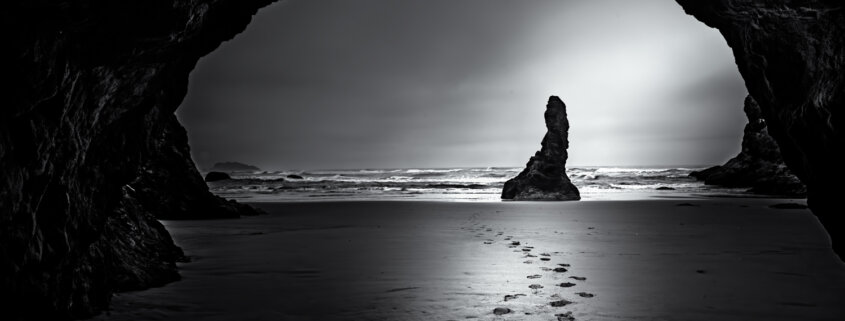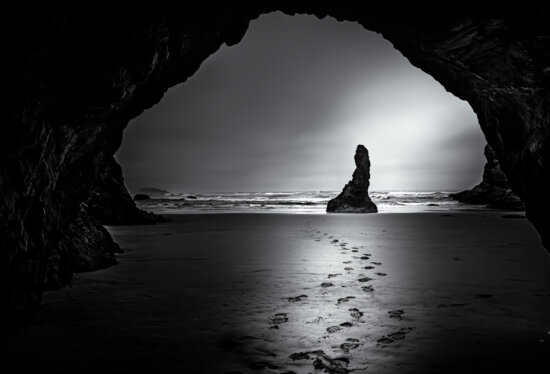How to Simplify Your Black and White Photography Compositions
When I first began my journey in nature photography in the early 70’s, like most I started out with black and white photography. I also did my own processing and printing of black and white nature photos. I can’t say my black and white photographic skills were that great in those days. To put it differently, much of my work really sucked. But it has been a quite a journey for sure.
Composition in Color Photography
As time progressed and skills matured, I began shooting solely in color. As a result, my nature photography style began to make use of strong foregrounds to help accentuate near-far relationships. Using a strong foreground as a key nature photography compositional element has become, I believe, a hallmark of many contemporary color nature photographers. Nothing wrong with such an approach mind you, and I have seen many talented photographers who are masters at this technique. Along with the strong foreground element, color also often becomes an important ally in helping lead one’s eye through the nature photography composition. Nonetheless, I had become bored with this approach in my own color photography work.
Consequently, a couple of years ago I decided it was time to return to my original love … black and white nature photography. In doing so, I found that to be most effective I had to adjust my photographic style to accommodate the need to simplify my black and white photography compositions. Without color as a compositional element, I needed greater focus on the subject. This required three things …. simplify, simplify, and simplify.
By focusing on the main subject you can create a strong visual impact with your black and white nature photos. Nature photography composition for black and white photography requires you to focus on light and shadows, objects, textures and contrast. Here are some tips for creating effective black and white photography composition:
Using Textures for Black and White Photography Compositions
The focus on texture can also offer a means to make your subject stand out from the background as seen in the image of the Wizard’s Hat on the Oregon coast below. Strong textures are used to draw your attention to the rock, but textures in rest of the images been de-emphasized or eliminated. Besides textures, I have used the edge of the surf to form a leading line towards the rock.
In a similar manner, the focus on texture can also offer a means to simplify. An example is how the image of the wharf ruins juxtaposes the smooth texture of the water, created using long exposure techniques, against the rough textures of the wharf pilings.
An important consideration when wanting to emphasize texture is lighting. Side lighting can be highly effective for textures because the angle of light will create a tactile quality of the subject or key element in your image. To illustrate, side lighting in the image of Cathedral Rocks in Yosemite national park actually contributes to a feeling of depth and a sense of the geological characteristics of the area. On the other hand, I used soft light and got close to really making the subject all about the texture in the Winter Ice Crystals image.
Tonal Contrast for Black and White Photography
Tonal contrast in black and white photography can be used quite effectively to simplify your composition. To illustrate both the images of the backlit aspens and sea stack in Brandon, Oregon have mostly tones on the extremes of the tonal scale. The backlit trees against the shadow of the hillsides behind isolates and emphasizes the subject, the trees. It pays to be mindful of such conditions when considering compositions. The results can be quite dramatic.
However, to be clear, your tonal contrast does not have to be extreme. In the image Aspen Field, there is a wide range of tonal values which were further emphasized by employing certain post processing tools in Lightroom. It is also important to consider that certain low contrast conditions such as fog and other weather phenomenon can be effective in conveying a certain mood. In any case, employing and controlling tonal contrast can truly help your composition stand out.
Photography Composition and Focal Length
As I adjusted my style for black and white, I found myself avoiding my once loved ultra-wide shots, opting for more normal to moderate and long telephoto shots to isolate detail. More like a transition from the wide grand landscape compositions to the more intimate landscapes. Using my long 100-400mm I was able to isolate the detail of the Upper McCord Creek Falls and thus simplify this image. And as in the previous examples, I used tonal contrast to emphasize the patterns resulting in almost an abstract black and white photography composition.
Black and white compositions really cry out for simplification. Using more normal to longer focal lengths aid in eliminating distracting elements and directing one’s eye to the main subject. In the image Rock Shelves of Old Man’s Cave Creek, a focal length of about 70mm was used to create this intimate landscape. The lighting provided an added feeling of depth.
Using Negative Space to capture Black & White Photos
A strong use of negative space can also be quite effective in simplifying your nature photography compositions. What is negative space? It is simply space surrounding the subject, which is often unoccupied. Effective use of negative space forces you to focus on the subject. Minimalism is a technique that strongly uses negative space in this manner. To demonstrate, I used this technique in creating the image of the dock pilings along the St. John’s river shown below. The negative space created by the long exposure and morning light on the water forces total attention to the dock remains. In a comparable manner, I used shadow, light and contrast to create negative space around the sandstone texture of a cave window of Rock House in Hocking Hills, Ohio.
Given these points, try to explore ways to simplify your black and white photos. Incorporate emphasis on texture, light and shadow, isolation of subject, and high contrast. And to really challenge yourself, trying your hand at stressing a minimalistic approach to your compositions. In a future post I will be exploring the concept of minimalism in more detail.




















